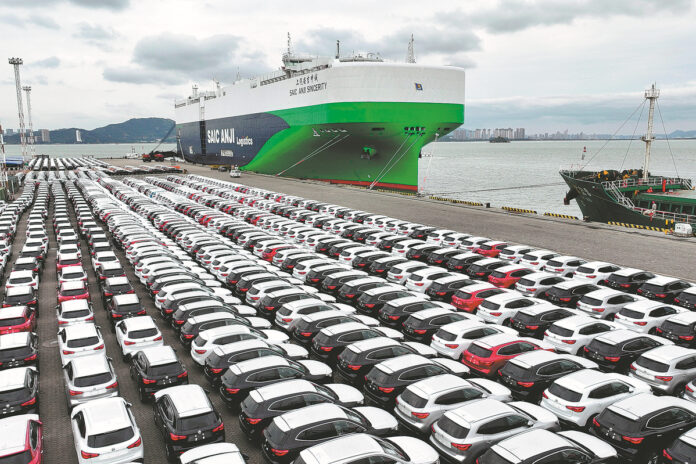In the evolving landscape of new energy vehicles, the dynamic between China and the European Union is often labeled as a trade war, but, in truth, what we see is a growing partnership, where both sides are doubling down on mutual investments.
While the EU voices ambitions to escape its “middle-tech trap,” it increasingly turns to China for solutions. Be it the influx of Chinese capital into European markets or the entwinement of European funds with Chinese innovation, the EU’s intentions are clear: gain access to China’s advanced technology. Reportedly, a striking surge has been observed this year in China’s greenfield investments in Europe, with nearly 70 percent tied to the electric vehicle supply chain.
Simultaneously, a reciprocal trend -European investments in China, particularly in greenfield projects, is also climbing. The automotive sector, in particular, saw its share of these investments swell from 33 percent pre-pandemic to 50 percent. It is not just about markets but about setting the standard in green technology. The EU, meanwhile, is trying to bridge its gaps by collaborating with an undisputed leader in innovation. Together, cooperation and competition are sparking a revolution in sustainable mobility.
Europe’s automotive industry, once a titan of tradition, finds itself grappling with the tectonic shift toward electrification and intelligence- a transition it failed to embrace early. The hard truth is that China now dominates the hardware supply chain, from upstream battery production and raw materials to downstream casting equipment. Even in areas like automotive chips, where Europe once held an edge, China is swiftly catching up. On the software front, particularly in intelligent driving technologies, China has established a global standing second only to the USA.
Europe, by contrast, faces a critical void in the tools and expertise required to assemble the electric and smart vehicles of tomorrow. Hardware, software, design- key elements determining a car’s value- remain largely outside Europe’s grasp. In this global race, China’s foresight underscores a reality Europe can no longer afford to ignore.
Meanwhile, the EU’s investment in areas like food, real estate, finance, and healthcare has tapered off. Instead, Europe’s focus is on the industries where China leads, such as information technology, aviation, and electronics. This shift underscores the potential of a deeper, more strategic partnership, where China isn’t just a market, but a critical centre of innovation driving global competitiveness.
The EU’s approach to its automotive industry crisis reflects a pragmatic, if not reluctant, acknowledgment of China’s pivotal role in the future of car manufacturing. Having fallen behind in the electrification and smart car race, the EU now finds itself leaning heavily on Chinese technology to stay competitive.
A recent The Financial Times report revealed that Brussels is inviting Chinese companies to bid on a major battery project, offering a €1 billion subsidy – but with the stipulation that China brings its advanced technology and shares it with the local market. If successful, this model could expand to other EU initiatives. The EU’s strategy, which includes imposing tariffs on Chinese electric vehicles, is not merely about market access- it is about learning.
China’s manufacturing expertise, particularly in the electric vehicle sector, is something European companies now recognize they cannot replicate independently. Beyond attracting greenfield investment from Chinese firms, Europe is keen to integrate further into China’s supply chain. By collaborating- sometimes competitively- it hopes to foster the next generation of industrial workers and innovation. In this delicate balance of cooperation and competition, Europe’s survival hinges on its ability to learn from the very force it once sought to rival.
Since China’s emergence from the pandemic, the EU has sharply increased its greenfield investments in the country, reaching €3.6 billion in the second quarter of this year—the highest quarterly figure in nearly a decade. This surge is not driven by a single large-scale deal; rather, it reflects a broader trend.
Compared to 2019-2022, both the number and average size of EU’s greenfield investments in China have grown significantly in the first half of 2022-2024. Some experts believe that the level of EU investment in China may have been underestimated because many companies now choose not to disclose their investments publicly to avoid drawing political attention or media scrutiny, particularly in light of the rising geopolitical tensions.
The EU’s investment in China is often attributed to the “In China, for China” strategy, focused on maintaining market share. While this rationale is widely accepted, the rise in EU investments seems counterintuitive given the sluggish demand within China’s domestic market. Unlike the EU, other global players such as the USA and Japan are scaling back their investments. In contrast, EU companies remain deeply committed to integrating into China’s growth, even as foreign capital flows into China have dropped overall— falling by 13.7 percent last year and an even steeper 29.1 percent in the first half of 2024.
A more compelling explanation for the EU’s ongoing investment in China lies not just in the market’s size, but in its increasingly pivotal role as an innovation hub and a source of exports for European companies.
While US policies, including hefty tariffs and the “connected car ban,” have pushed Chinese supply chains out of the North American market, European companies continue to benefit from access to China’s vast consumer base and its growing leadership in various industrial sectors.
China’s competitive edge in innovation and industrialization, particularly in automotive and high-tech materials, has drawn significant EU investment. The EU’s stake in China’s automotive industry alone has risen sharply, from 33 percent to 50 percent. These sectors – automotive and key materials – are crucial to Europe, with China as both a major supplier and a cutting-edge partner.
Meanwhile, the EU’s investment in areas like food, real estate, finance, and healthcare has tapered off. Instead, Europe’s focus is on the industries where China leads, such as information technology, aviation, and electronics. This shift underscores the potential of a deeper, more strategic partnership, where China isn’t just a market, but a critical centre of innovation driving global competitiveness.























